Overview
- Brief Narrative
- Pillow cover carried by 10-year-old Ina Felczer on a Kindertransport [Children's Transport] to Leeds, England, in late June 1939. Before the war, Ina lived with her parents, Victor and Hannah, in Berlin, Germany. Both were Polish Jews who had lived in Berlin since the 1920s. Victor was a chemist, and Hannah co-owned a dressmaking shop. On January 30, 1933, Adolf Hitler was appointed Chancellor of Germany, and authorities throughout Germany quickly began suppressing the rights of Jews and boycotting their businesses. In the late 1930’s, Victor lost his job, and Hannah’s shop was destroyed by the authorities, though she continued to operate it from their home. In 1938, Victor was deported to Poland. In 1939, Hannah registered Ina for a Kindertransport, which arrived in England on June 30. Three days after Ina left, Hannah was deported to Poznan, Poland. In England, Ina lived with Vera and Sol Fischer in Leeds, before being evacuated to Harmston with other children to avoid the dangers of German air raids and bombings on cities. Eventually, Ina was moved to a girl’s hostel in Harrogate where she lived until 1945, when the war ended and it closed. Both of Ina's parents, her maternal grandparents, and many relatives perished in the Holocaust. In June 1946, Ina immigrated to the United States to live with her aunt in New Jersey.
- Date
-
use:
1939-1945
emigration: 1939 June
- Geography
-
use:
Great Britain
- Credit Line
- United States Holocaust Memorial Museum Collection, Gift of Ina Felczer
- Contributor
-
Subject:
Ina Felczer
- Biography
-
Ina Felczer (b.1929) was born in Berlin, Germany, to Hannah (Hana, née Kempinski, 1894-?) and Victor Awigdor (1892 -?) Felczer. Hannah was born in Kalisz, Poland, to Golda (née Ostrowsky) and Judah Kempinski. Victor was born in Przystajnia (near Błaszki), Poland, to Ester (née Shvartz) and Abraham Leib Felczer. Both Hannah and Victor moved to Berlin in the 1920s; Victor was a chemist and Hannah co-owned a dressmaking shop. On January 30, 1933, Adolf Hitler was appointed chancellor of Germany, and authorities throughout the country quickly began suppressing the rights of Jews and boycotting their businesses. Hannah was very protective of Ina, and often reminded her to avoid conspicuous behavior because it was risky with the escalation of anti-Jewish laws in Germany.
In the late 1930’s, Hannah’s shop was destroyed by the authorities. Despite this, she continued to operate the business out of the family's home, along with her partner, Mrs. Berliner, and two hired, German seamstresses. Due to the increased Aryanization efforts and the passage of more anti-Jewish legislation, Victor lost his job in 1938. Occasionally, Victor secured work as a house painter, which he had to keep quiet so the seamstresses would not find out and tell the authorities. Later that year, Victor was deported to his native Poland. In 1939, Hannah registered Ina for the Kindertransport [Children’s Transport], a rescue mission to save Jewish children. The registration was managed by Bloomsbury House, a group of Jewish aid societies in Great Britain. Ina arrived in Great Britain on June 30, having left her mother behind in Berlin. Three days after Ina left, Hannah was arrested and deported to Poznan, Poland. Hannah’s brother, Froim (Efraim), lived in Poznan with his wife, Yetka, and their son, Fishel.
Once in England, Ina was cared for by Vera and Sol Fischer, a Jewish couple in Leeds. Ina was placed in a local elementary school, and worked hard to learn a new language and culture. In September 1939, Germany invaded Poland, and two days later Great Britain and France declared war on Germany. In response to this declaration, many children were evacuated from major urban centers in Great Britain. Ina was first evacuated to Lincolnshire. Then she was sent to Harmston, where she held a newly issued gas mask, a tin of condensed milk, and a chocolate bar in her lap in the village hall while waiting for adults to come get her. Ina was placed in the home of some local farmers. Later, she got lice and moved to Christian couple’s home. At some point in 1940, Ina returned to the Fischers’ care in Leeds. Beginning in the fall, several air raids made Leeds a dangerous place to be. Additionally, Vera had bad arthritis and could not handle all of the extra work associated with caring for a child, so Ina was sent to live in a girl’s hostel in the nearby town of Harrogate. Ina lived at the hostel for five years, until it closed in 1945. Ina had some family members in England, but chose to move in with Vera’s brother after the hostel closed. Germany surrendered in May 1945, ending the war in Europe.
On June 8, 1946, Ina boarded the S.S. Drottningholm in Liverpool, England and sailed to the United States, arriving eight days later in New York City. She went to live with her aunt in New Jersey, where she finished high school, found work, and attended night courses for college. She became a US citizen in April 1952, and three months later, she boarded a ship to England. She lived in Paris, France, working as a librarian, for 17 months before returning to the US in 1954.
After the war, Ina learned that much of her family had been killed during the Holocaust. Ina’s father, Victor, had been transported to the Warsaw ghetto sometime after his deportation to Poland. Ina’s mother, Hannah, and her grandmother, Golda, were transported to the Warsaw ghetto between September 1939 and October 1940. Ina’s grandfather, Judah, was likely deported to Warsaw as well. The last records for Victor, Hannah, and Golda indicate that they were in the ghetto on October 26, 1940. In an effort to make Poznań Judenrein [free of Jews], German authorities had deported most of the Jews in that community, including Ina’s relatives that lived there, to Warsaw, Łódź, Ostrów Lubelski, or other towns in the Generalgouvernement region of German-occupied Poland. Ina’s uncle, Froim, was transported to the Łódź ghetto, and later killed. Froim, his wife, Yetka, and their son, Fischel, were among Ina’s many relatives who were killed during the Holocaust.
Physical Details
- Classification
-
Furnishings and Furniture
- Category
-
Household linens
- Object Type
-
Pillowcases (lcsh)
- Genre/Form
- Bedsheets.
- Physical Description
- Rectangular pouch made of offwhite cloth with a pattern of orange and blue flowers on brown branches. It has rounded corners and a broken, silver colored, metal zipper closure.
- Dimensions
- overall: Height: 9.375 inches (23.813 cm) | Width: 14.125 inches (35.878 cm)
- Materials
- overall : cloth, metal
Rights & Restrictions
- Conditions on Access
- No restrictions on access
- Conditions on Use
- No restrictions on use
Keywords & Subjects
- Topical Term
- Kindertransports (Rescue operations)--Great Britain. Jewish children in the Holocaust--Germany. Jewish refugees--Great Britain. Holocaust, Jewish (1939-1945)--Germany--Berlin--Personal narratives. World War, 1939-1945--Refugees--Great Britain.
- Geographic Name
- Berlin (Germany) Leeds (England) Lincolnshire (England) Harrogate (England) United States. Poznań (Poland) Warsaw (Poland) Poland.
- Corporate Name
- Getto warszawskie (Warsaw, Poland)
Administrative Notes
- Legal Status
- Permanent Collection
- Provenance
- The pillow cover was donated to the United States Holocaust Memorial Museum in 2006 by Ina Felczer.
- Record last modified:
- 2022-08-15 07:29:07
- This page:
- https://collections.ushmm.org/search/catalog/irn34287
Download & Licensing
In-Person Research
- By Appointment
- Request 21 Days in Advance of Visit
- Plan a Research Visit
- Request to See This Object
Contact Us
Also in Ina Felczer collection
The collection consists of a felt doll, handkerchiefs with a case, a child’s Hebrew reader, dishes, a pillow cover, school supplies, documents, and photographs relating to the experiences of Ina Felczer in Germany before the Holocaust and as a Kindertransport refugee in England during World War II.
Date: approximately 1905-1945
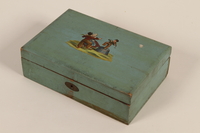
Green school box carried by a Kindertransport refugee
Object
School box carried by 10-year-old Ina Felczer on a Kindertransport [Children's Transport] to Leeds, England, in late June 1939. Before the war, Ina lived with her parents, Victor and Hannah, in Berlin, Germany. Both were Polish Jews who had lived in Berlin since the 1920s. Victor was a chemist, and Hannah co-owned a dressmaking shop. On January 30, 1933, Adolf Hitler was appointed Chancellor of Germany, and authorities throughout Germany quickly began suppressing the rights of Jews and boycotting their businesses. In the late 1930’s, Victor lost his job, and Hannah’s shop was destroyed by the authorities, though she continued to operate it from their home. In 1938, Victor was deported to Poland. In 1939, Hannah registered Ina for a Kindertransport, which arrived in England on June 30. Three days after Ina left, Hannah was deported to Poznan, Poland. In England, Ina lived with Vera and Sol Fischer in Leeds, before being evacuated to Harmston with other children to avoid the dangers of German air raids and bombings on cities. Eventually, Ina was moved to a girl’s hostel in Harrogate where she lived until 1945, when the war ended and it closed. Both of Ina's parents, her maternal grandparents, and many relatives perished in the Holocaust. In June 1946, Ina immigrated to the United States to live with her aunt in New Jersey.
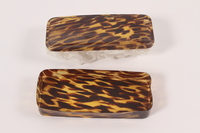
Tortoiseshell pencil box and lid carried by a Kindertransport refugee
Object
Plastic pencil box carried by 10-year-old Ina Felczer on a Kindertransport [Children's Transport] to Leeds, England, in late June 1939. Before the war, Ina lived with her parents, Victor and Hannah, in Berlin, Germany. Both were Polish Jews who had lived in Berlin since the 1920s. Victor was a chemist, and Hannah co-owned a dressmaking shop. On January 30, 1933, Adolf Hitler was appointed Chancellor of Germany, and authorities throughout Germany quickly began suppressing the rights of Jews and boycotting their businesses. In the late 1930’s, Victor lost his job, and Hannah’s shop was destroyed by the authorities, though she continued to operate it from their home. In 1938, Victor was deported to Poland. In 1939, Hannah registered Ina for a Kindertransport, which arrived in England on June 30. Three days after Ina left, Hannah was deported to Poznan, Poland. In England, Ina lived with Vera and Sol Fischer in Leeds, before being evacuated to Harmston with other children to avoid the dangers of German air raids and bombings on cities. Eventually, Ina was moved to a girl’s hostel in Harrogate where she lived until 1945, when the war ended and it closed. Both of Ina's parents, her maternal grandparents, and many relatives perished in the Holocaust. In June 1946, Ina immigrated to the United States to live with her aunt in New Jersey.
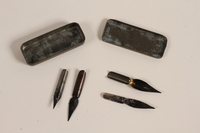
Drafting kit with 18 drawing implements used by a Kindertransport refugee
Object
Drafting box and supplies carried by 10-year-old Ina Felczer on a Kindertransport [Children's Transport] to Leeds, England, in late June 1939. Before the war, Ina lived with her parents, Victor and Hannah, in Berlin, Germany. Both were Polish Jews who had lived in Berlin since the 1920s. Victor was a chemist, and Hannah co-owned a dressmaking shop. On January 30, 1933, Adolf Hitler was appointed Chancellor of Germany, and authorities throughout Germany quickly began suppressing the rights of Jews and boycotting their businesses. In the late 1930’s, Victor lost his job, and Hannah’s shop was destroyed by the authorities, though she continued to operate it from their home. In 1938, Victor was deported to Poland. In 1939, Hannah registered Ina for a Kindertransport, which arrived in England on June 30. Three days after Ina left, Hannah was deported to Poznan, Poland. In England, Ina lived with Vera and Sol Fischer in Leeds, before being evacuated to Harmston with other children to avoid the dangers of German air raids and bombings on cities. Eventually, Ina was moved to a girl’s hostel in Harrogate where she lived until 1945, when the war ended and it closed. Both of Ina's parents, her maternal grandparents, and many relatives perished in the Holocaust. In June 1946, Ina immigrated to the United States to live with her aunt in New Jersey.
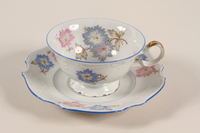
Teacup and saucer with blue and pink flowers carried by Kindertransport refugee
Object
Decorated children’s plate manufactured by Porzellanfabrik Bareuther & Co. and carried by 10-year-old Ina Felczer on a Kindertransport [Children's Transport] to Leeds, England, in late June 1939. Before the war, Ina lived with her parents, Victor and Hannah, in Berlin, Germany. Both were Polish Jews who had lived in Berlin since the 1920s. Victor was a chemist, and Hannah co-owned a dressmaking shop. On January 30, 1933, Adolf Hitler was appointed Chancellor of Germany, and authorities throughout Germany quickly began suppressing the rights of Jews and boycotting their businesses. In the late 1930’s, Victor lost his job, and Hannah’s shop was destroyed by the authorities, though she continued to operate it from their home. In 1938, Victor was deported to Poland. In 1939, Hannah registered Ina for a Kindertransport, which arrived in England on June 30. Three days after Ina left, Hannah was deported to Poznan, Poland. In England, Ina lived with Vera and Sol Fischer in Leeds, before being evacuated to Harmston with other children to avoid the dangers of German air raids and bombings on cities. Eventually, Ina was moved to a girl’s hostel in Harrogate where she lived until 1945, when the war ended and it closed. Both of Ina's parents, her maternal grandparents, and many relatives perished in the Holocaust. In June 1946, Ina immigrated to the United States to live with her aunt in New Jersey.
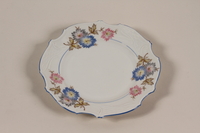
Salad plate with a floral design carried by Kindertransport refugee
Object
Decorated children’s plate manufactured by Porzellanfabrik Bareuther & Co. and carried by 10-year-old Ina Felczer on a Kindertransport [Children's Transport] to Leeds, England, in late June 1939. Before the war, Ina lived with her parents, Victor and Hannah, in Berlin, Germany. Both were Polish Jews who had lived in Berlin since the 1920s. Victor was a chemist, and Hannah co-owned a dressmaking shop. On January 30, 1933, Adolf Hitler was appointed Chancellor of Germany, and authorities throughout Germany quickly began suppressing the rights of Jews and boycotting their businesses. In the late 1930’s, Victor lost his job, and Hannah’s shop was destroyed by the authorities, though she continued to operate it from their home. In 1938, Victor was deported to Poland. In 1939, Hannah registered Ina for a Kindertransport, which arrived in England on June 30. Three days after Ina left, Hannah was deported to Poznan, Poland. In England, Ina lived with Vera and Sol Fischer in Leeds, before being evacuated to Harmston with other children to avoid the dangers of German air raids and bombings on cities. Eventually, Ina was moved to a girl’s hostel in Harrogate where she lived until 1945, when the war ended and it closed. Both of Ina's parents, her maternal grandparents, and many relatives perished in the Holocaust. In June 1946, Ina immigrated to the United States to live with her aunt in New Jersey.
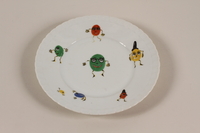
Plate with colorful, oval-shaped cartoon figures carried by a Kindertransport refugee
Object
Decorated children’s plate manufactured by Beyer and Bock and carried by 10-year-old Ina Felczer on a Kindertransport [Children's Transport] to Leeds, England, in late June 1939. Before the war, Ina lived with her parents, Victor and Hannah, in Berlin, Germany. Both were Polish Jews who had lived in Berlin since the 1920s. Victor was a chemist, and Hannah co-owned a dressmaking shop. On January 30, 1933, Adolf Hitler was appointed Chancellor of Germany, and authorities throughout Germany quickly began suppressing the rights of Jews and boycotting their businesses. In the late 1930’s, Victor lost his job, and Hannah’s shop was destroyed by the authorities, though she continued to operate it from their home. In 1938, Victor was deported to Poland. In 1939, Hannah registered Ina for a Kindertransport, which arrived in England on June 30. Three days after Ina left, Hannah was deported to Poznan, Poland. In England, Ina lived with Vera and Sol Fischer in Leeds, before being evacuated to Harmston with other children to avoid the dangers of German air raids and bombings on cities. Eventually, Ina was moved to a girl’s hostel in Harrogate where she lived until 1945, when the war ended and it closed. Both of Ina's parents, her maternal grandparents, and many relatives perished in the Holocaust. In June 1946, Ina immigrated to the United States to live with her aunt in New Jersey.
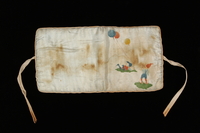
White handkerchief pouch with gnomes carried by a Kindertransport refugee
Object
Handkerchief holder carried by 10-year-old Ina Felczer on a Kindertransport [Children's Transport] to Leeds, England, in late June 1939. Before the war, Ina lived with her parents, Victor and Hannah, in Berlin, Germany. Both were Polish Jews who had lived in Berlin since the 1920s. Victor was a chemist, and Hannah co-owned a dressmaking shop. On January 30, 1933, Adolf Hitler was appointed Chancellor of Germany, and authorities throughout Germany quickly began suppressing the rights of Jews and boycotting their businesses. In the late 1930’s, Victor lost his job, and Hannah’s shop was destroyed by the authorities, though she continued to operate it from their home. In 1938, Victor was deported to Poland. In 1939, Hannah registered Ina for a Kindertransport, which arrived in England on June 30. Three days after Ina left, Hannah was deported to Poznan, Poland. In England, Ina lived with Vera and Sol Fischer in Leeds, before being evacuated to Harmston with other children to avoid the dangers of German air raids and bombings on cities. Eventually, Ina was moved to a girl’s hostel in Harrogate where she lived until 1945, when the war ended and it closed. Both of Ina's parents, her maternal grandparents, and many relatives perished in the Holocaust. In June 1946, Ina immigrated to the United States to live with her aunt in New Jersey.
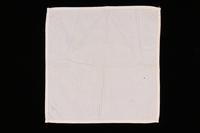
White handkerchief with a stitched border carried by a Kindertransport refugee
Object
Handkerchief carried by 10-year-old Ina Felczer on a Kindertransport [Children's Transport] to Leeds, England, in late June 1939. Before the war, Ina lived with her parents, Victor and Hannah, in Berlin, Germany. Both were Polish Jews who had lived in Berlin since the 1920s. Victor was a chemist, and Hannah co-owned a dressmaking shop. On January 30, 1933, Adolf Hitler was appointed Chancellor of Germany, and authorities throughout Germany quickly began suppressing the rights of Jews and boycotting their businesses. In the late 1930’s, Victor lost his job, and Hannah’s shop was destroyed by the authorities, though she continued to operate it from their home. In 1938, Victor was deported to Poland. In 1939, Hannah registered Ina for a Kindertransport, which arrived in England on June 30. Three days after Ina left, Hannah was deported to Poznan, Poland. In England, Ina lived with Vera and Sol Fischer in Leeds, before being evacuated to Harmston with other children to avoid the dangers of German air raids and bombings on cities. Eventually, Ina was moved to a girl’s hostel in Harrogate where she lived until 1945, when the war ended and it closed. Both of Ina's parents, her maternal grandparents, and many relatives perished in the Holocaust. In June 1946, Ina immigrated to the United States to live with her aunt in New Jersey.
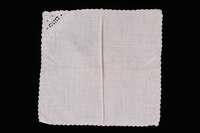
White handkerchief with openwork flowers carried by a Kindertransport refugee
Object
Handkerchief carried by 10-year-old Ina Felczer on a Kindertransport [Children's Transport] to Leeds, England, in late June 1939. Before the war, Ina lived with her parents, Victor and Hannah, in Berlin, Germany. Both were Polish Jews who had lived in Berlin since the 1920s. Victor was a chemist, and Hannah co-owned a dressmaking shop. On January 30, 1933, Adolf Hitler was appointed Chancellor of Germany, and authorities throughout Germany quickly began suppressing the rights of Jews and boycotting their businesses. In the late 1930’s, Victor lost his job, and Hannah’s shop was destroyed by the authorities, though she continued to operate it from their home. In 1938, Victor was deported to Poland. In 1939, Hannah registered Ina for a Kindertransport, which arrived in England on June 30. Three days after Ina left, Hannah was deported to Poznan, Poland. In England, Ina lived with Vera and Sol Fischer in Leeds, before being evacuated to Harmston with other children to avoid the dangers of German air raids and bombings on cities. Eventually, Ina was moved to a girl’s hostel in Harrogate where she lived until 1945, when the war ended and it closed. Both of Ina's parents, her maternal grandparents, and many relatives perished in the Holocaust. In June 1946, Ina immigrated to the United States to live with her aunt in New Jersey.
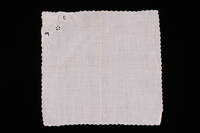
White handkerchief with a fan design carried by a Kindertransport refugee
Object
Handkerchief carried by 10-year-old Ina Felczer on a Kindertransport [Children's Transport] to Leeds, England, in late June 1939. Before the war, Ina lived with her parents, Victor and Hannah, in Berlin, Germany. Both were Polish Jews who had lived in Berlin since the 1920s. Victor was a chemist, and Hannah co-owned a dressmaking shop. On January 30, 1933, Adolf Hitler was appointed Chancellor of Germany, and authorities throughout Germany quickly began suppressing the rights of Jews and boycotting their businesses. In the late 1930’s, Victor lost his job, and Hannah’s shop was destroyed by the authorities, though she continued to operate it from their home. In 1938, Victor was deported to Poland. In 1939, Hannah registered Ina for a Kindertransport, which arrived in England on June 30. Three days after Ina left, Hannah was deported to Poznan, Poland. In England, Ina lived with Vera and Sol Fischer in Leeds, before being evacuated to Harmston with other children to avoid the dangers of German air raids and bombings on cities. Eventually, Ina was moved to a girl’s hostel in Harrogate where she lived until 1945, when the war ended and it closed. Both of Ina's parents, her maternal grandparents, and many relatives perished in the Holocaust. In June 1946, Ina immigrated to the United States to live with her aunt in New Jersey.
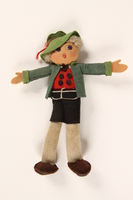
Blonde haired, male, felt doll carried by a Kindertransport refugee
Object
Felt doll carried by 10-year-old Ina Felczer on a Kindertransport [Children's Transport] to Leeds, England, in late June 1939. Before the war, Ina lived with her parents, Victor and Hannah, in Berlin, Germany. Both were Polish Jews who had lived in Berlin since the 1920s. Victor was a chemist, and Hannah co-owned a dressmaking shop. On January 30, 1933, Adolf Hitler was appointed Chancellor of Germany, and authorities throughout Germany quickly began suppressing the rights of Jews and boycotting their businesses. In the late 1930’s, Victor lost his job, and Hannah’s shop was destroyed by the authorities, though she continued to operate it from their home. In 1938, Victor was deported to Poland. In 1939, Hannah registered Ina for a Kindertransport, which arrived in England on June 30. Three days after Ina left, Hannah was deported to Poznan, Poland. In England, Ina lived with Vera and Sol Fischer in Leeds, before being evacuated to Harmston with other children to avoid the dangers of German air raids and bombings on cities. Eventually, Ina was moved to a girl’s hostel in Harrogate where she lived until 1945, when the war ended and it closed. Both of Ina's parents, her maternal grandparents, and many relatives perished in the Holocaust. In June 1946, Ina immigrated to the United States to live with her aunt in New Jersey.
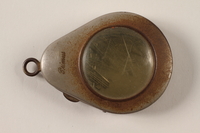
Pin box and 57 straight pins carried by a Kindertransport refugee
Object
Pin case with 57 pins carried by 10-year-old Ina Felczer on a Kindertransport [Children's Transport] to Leeds, England, in late June 1939. Before the war, Ina lived with her parents, Victor and Hannah, in Berlin, Germany. Both were Polish Jews who had lived in Berlin since the 1920s. Victor was a chemist, and Hannah co-owned a dressmaking shop. On January 30, 1933, Adolf Hitler was appointed Chancellor of Germany, and authorities throughout Germany quickly began suppressing the rights of Jews and boycotting their businesses. In the late 1930’s, Victor lost his job, and Hannah’s shop was destroyed by the authorities, though she continued to operate it from their home. In 1938, Victor was deported to Poland. In 1939, Hannah registered Ina for a Kindertransport, which arrived in England on June 30. Three days after Ina left, Hannah was deported to Poznan, Poland. In England, Ina lived with Vera and Sol Fischer in Leeds, before being evacuated to Harmston with other children to avoid the dangers of German air raids and bombings on cities. Eventually, Ina was moved to a girl’s hostel in Harrogate where she lived until 1945, when the war ended and it closed. Both of Ina's parents, her maternal grandparents, and many relatives perished in the Holocaust. In June 1946, Ina immigrated to the United States to live with her aunt in New Jersey.
Ina Felczer papers
Document
Collection consists of two photograph albums and documenting the experiences of Ina Felczer during the Holocaust
Hebrew reader carried by a Kindertransport refugee
Object
Part two of the Hebrew reader "Dan und Gad," carried by 10-year-old Ina Felczer on a Kindertransport [Children's Transport] to Leeds, England, in late June 1939. Before the war, Ina lived with her parents, Victor and Hannah, in Berlin, Germany. Both were Polish Jews who had lived in Berlin since the 1920s. Victor was a chemist, and Hannah co-owned a dressmaking shop. On January 30, 1933, Adolf Hitler was appointed Chancellor of Germany, and authorities throughout Germany quickly began suppressing the rights of Jews and boycotting their businesses. In the late 1930’s, Victor lost his job, and Hannah’s shop was destroyed by the authorities, though she continued to operate it from their home. In 1938, Victor was deported to Poland. In 1939, Hannah registered Ina for a Kindertransport, which arrived in England on June 30. Three days after Ina left, Hannah was deported to Poznan, Poland. In England, Ina lived with Vera and Sol Fischer in Leeds, before being evacuated to Harmston with other children to avoid the dangers of German air raids and bombings on cities. Eventually, Ina was moved to a girl’s hostel in Harrogate where she lived until 1945, when the war ended and it closed. Both of Ina's parents, her maternal grandparents, and many relatives perished in the Holocaust. In June 1946, Ina immigrated to the United States to live with her aunt in New Jersey.



